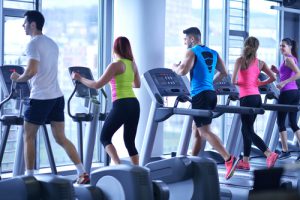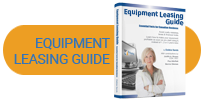Most gyms allocate an average of 60% of their floor space for strength and cardio equipment. Industry metrics can be helpful in determining the right balance of floor space to use for cardio and strength equipment and there are great tools available online to help you plan your gym space, but deciding on the right equipment for your gym can be a major endeavour and have a serious impact on your budget and operating expenses going forward. Commercial fitness facilities and corporations creating gyms for their employees can lease or buy the new equipment. Here are some helpful fitness industry benchmarks, tools and insights into leasing versus financing or buying, followed by some local resources.
Plan your Gym Space Carefully
 According to Precor, 40% of the typical fitness facility is allocated to reception area, locker rooms, hallways and other non-exercise areas. Of the remaining sixty percent, 47% is allocated to strength equipment, 33% to cardio and 20% to group exercise space.
According to Precor, 40% of the typical fitness facility is allocated to reception area, locker rooms, hallways and other non-exercise areas. Of the remaining sixty percent, 47% is allocated to strength equipment, 33% to cardio and 20% to group exercise space.
You can use the Cybex Gym Planner (link below) to create 2D and 3D plans for your space. This planner lets you visually create your space and then allocate the types of strength and cardio equipment such as Elliptical Cross Training Machines, Treadmills, Rowers, Stationary Bikes and Step Machines to scale on the floor space.
Determining which equipment you need is only part of the equation. The other question to ask is will you be better off in the long run paying cash, taking a loan or leasing the equipment? Going with a gut feel or doing things the way you always have may not be the best method. Perhaps consult a tax advisor to understand the best strategy before you finalize the purchase and avoid possible disappointment later, at tax time, or when you decide to upgrade the equipment.
To Lease or Buy Your Gym Equipment?
In addition to deciding on the types and quantities of equipment you’ll need for your gym, it’s a good idea to understand the pros and cons of leasing versus buying the equipment. Here are a few considerations to keep in mind and to discuss with your advisor.
1. Keeping your gym’s equipment modern and up-to-date
If you have operated any kind of gym or fitness facility you know it’s important to have modern, up-to-date equipment. Every few years, new machines are developed and become the latest craze in demand by gym members (stair climbers replaced by elliptical machines!). Cardio equipment manufacturers are continually improving their equipment lines, adding new computerized features, technologies, sensors and devices. If a competing gym offers more current fitness technology than you, it may be enough to send prospective members to your competition.
Usually it’s a good idea to match the lease term to the length of the equipment warranty, often three years. Why? Because it can only take a few short years to show ware and become visibly outdated. If you choose to upgrade your equipment on a regular basis, you may avoid repair costs that may otherwise not be covered under warranty.
Usually it’s a good idea to match the lease term to the length of the equipment warranty
The rate at which fitness equipment evolves can make keeping up painful. The balance between maintaining your gym’s competitive edge and a healthy balance sheet can be a worthwhile exercise!
2. Turning equipment over and dealing with the used asset
As we discussed in the previous point, eventually your gym’s equipment will become outdated or start to show it’s age. Leasing can take the pain out of updating equipment. This is largely because fitness equipment is a depreciating asset. If it appreciated, owning the equipment would make more sense because it would be worth more at the end of the loan or after you paid cash.
The flexibility to upgrade your fitness equipment on a regular basis without increasing costs or having to deal with obsolete equipment are some of the main reasons gyms utilize leasing to finance their equipment. At the end of the lease term, you can exercise your option to return the old equipment to the lessor, no questions asked, and / or order new equipment to be financed using a similar formula. You many also elect to buy it out at a predetermined value. In Canada, we write most of our gym equipment leases with a $10 lease end buy out but sometimes they can be written with a fair market value buyout or a buy out based on 10% of the original purchase price. At this point you are free to order new equipment, and your lease payments usually stay around the same. As long as you have made payments on time, your leasing company will be happy to provide you with a new lease.
In Canada, we write most of our gym equipment leases with a $10 lease end buy out
To sum up this point. When it’s time to upgrade … if you bought the equipment you will need to either sell it or dispose of it. If you leased the equipment, you have two options, you can return it to the leasing company, or buy it out at a low predetermined price.
3. Paying LESS taxes
When you lease equipment for your commercial or corporate gym, you’ll be able to write off 100% of the lease payments from your taxable corporate income. Compare this to buying the equipment, and only writing off the depreciation each year. This means referring to tax tables that list set depreciation rates on a yearly basis and then calculating the depreciation based on the remaining value from the previous year. Yes, it can get a little complex. The main takeaway is that leasing is a 100% write off, while buying or taking a loan is only a partial write off.
leasing is a 100% write off, while buying or taking a loan is only a partial write off.
For example, if you want to own your equipment and take a loan for equipment that depreciates by 25% per year, you get to write off 25% of your loan payments for that year. As mentioned, with leasing you can write off the entire payment.
If you choose to buy the asset (equipment) at the end of the lease, and then resell it, you add the sale amount back to the value of the equipment before you calculate the deprecation. For more information about writing off depreciation in Canada see the source links below or consult your tax advisor.
4. Keeping your access to credit open
When using leasing to finance your equipment, you can treat payments as an operating expense instead of a capital cost. As such, they do not appear as a liability which may support other requests you make for credit.
Popular Types of Cardio Equipment You Can Lease and Where To Get It
The types of equipment we lease the most include:
- Elliptical Cross Training Machines
- Treadmills
- Rowers
- Stationary Bikes
- Step Machines
In Western Canada, popular places to order equipment for your commercial or corporate gym include:
In one of my next posts we’ll take a closer look at the financing of fitness equipment and different lease types, so stay tuned.
Sources referenced:
Cardio Equipment Leasing Strategies for Fitness Centers
How to Choose Fitness Equipment for Your Gym
http://www.precor.com/en-us/blog/2015/04/22/how-to-choose- fitness-equipment-for-your-gym/
Writing off depreciation on equipment you purchase:
http://www.taxplanningguide.ca/tax-planning-guide/section-1-businesses/calculating-depreciation/


